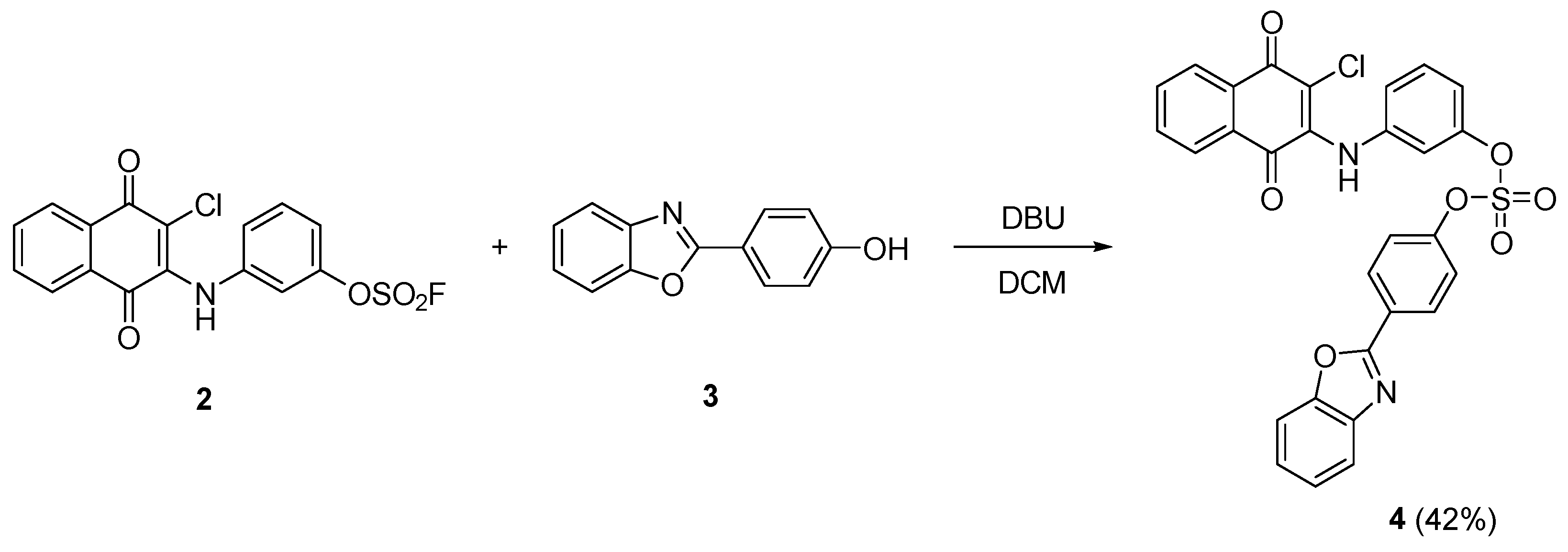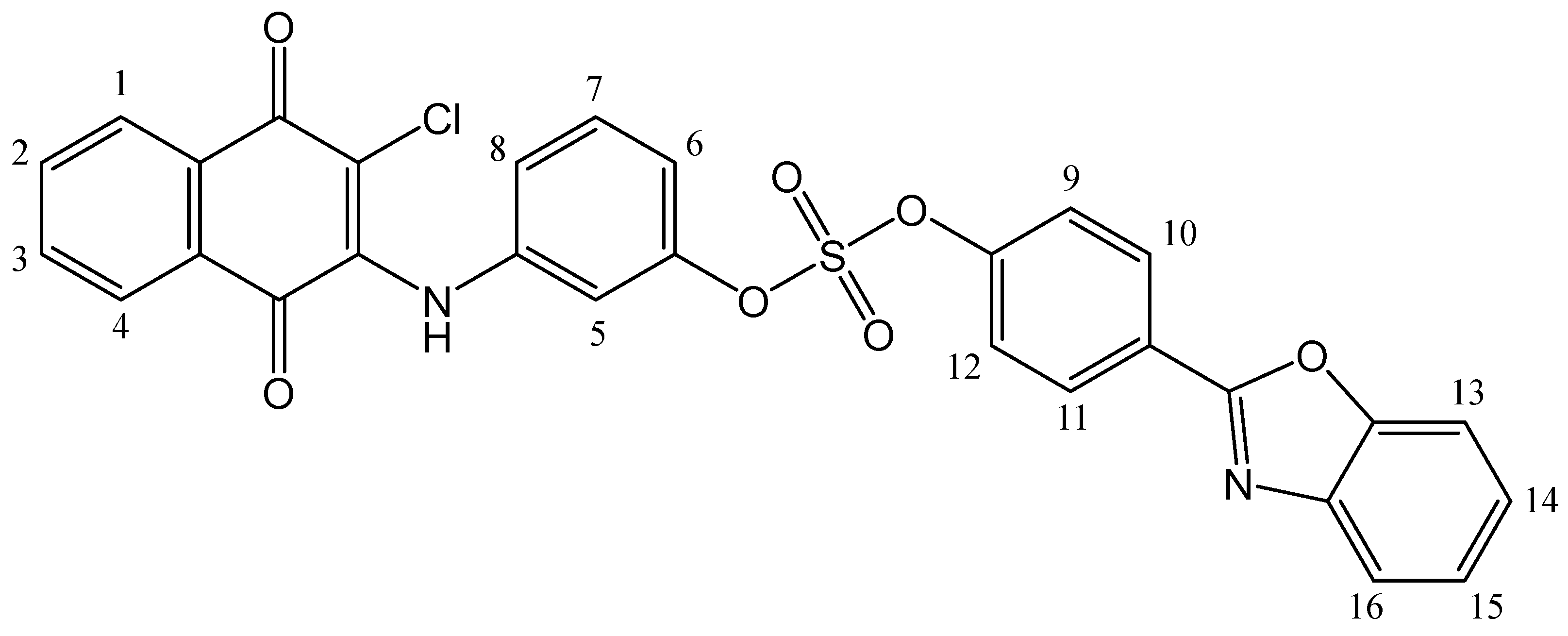4-(Benzoxazol-2-yl)phenyl 3-((3-Chloro-1,4-Naphthoquinon-2-yl)amino)phenyl Sulfate
Abstract
1. Introduction
2. Results
3. Materials and Methods
General Information and Compounds Synthesis
4. Conclusions
Supplementary Materials
Author Contributions
Funding
Data Availability Statement
Acknowledgments
Conflicts of Interest
References
- Uchimiya, M.; Stone, A.T. Reversible Redox Chemistry of Quinones: Impact on Biogeochemical Cycles. Chemosphere 2009, 77, 451–458. [Google Scholar] [CrossRef] [PubMed]
- Navarro-Tovar, G.; Vega-Rodríguez, S.; Leyva, E.; Loredo-Carrillo, S.; de Loera, D.; López-López, L.I. The Relevance and Insights on 1,4-Naphthoquinones as Antimicrobial and Antitumoral Molecules: A Systematic Review. Pharmaceuticals 2023, 16, 496. [Google Scholar] [CrossRef] [PubMed]
- Schepetkin, I.A.; Karpenko, A.S.; Khlebnikov, A.I.; Shibinska, M.O.; Levandovskiy, I.A.; Kirpotina, L.N.; Danilenko, N.V.; Quinn, M.T. Synthesis, Anticancer Activity, and Molecular Modeling of 1,4-Naphthoquinones That Inhibit MKK7 and Cdc25. Eur. J. Med. Chem. 2019, 183, 111719. [Google Scholar] [CrossRef] [PubMed]
- Singh, S.; Veeraswamy, G.; Bhattarai, D.; Goo, J.-I.; Lee, K.; Choi, Y. Recent Advances in the Development of Pharmacologically Active Compounds That Contain a Benzoxazole Scaffold. Asian J. Org. Chem. 2015, 4, 1338–1361. [Google Scholar] [CrossRef]
- Sattar, R.; Mukhtar, R.; Atif, M.; Hasnain, M.; Irfan, A. Synthetic Transformations and Biological Screening of Benzoxazole Derivatives: A Review. J. Heterocycl. Chem. 2020, 57, 2079–2107. [Google Scholar] [CrossRef]
- Murty, M.S.R.; Ram, K.R.; Rao, R.V.; Yadav, J.S.; Rao, J.V.; Cheriyan, V.T.; Anto, R.J. Synthesis and Preliminary Evaluation of 2-Substituted-1,3-Benzoxazole and 3-[(3-Substituted)Propyl]-1,3-Benzoxazol-2(3H)-One Derivatives as Potent Anticancer Agents. Med. Chem. Res. 2011, 20, 576–586. [Google Scholar] [CrossRef]
- Saluja, P.; Sharma, H.; Kaur, N.; Singh, N.; Jang, D.O. Benzimidazole-Based Imine-Linked Chemosensor: Chromogenic Sensor for Mg2+ and Fluorescent Sensor for Cr3+. Tetrahedron 2012, 68, 2289–2293. [Google Scholar] [CrossRef]
- Dong, J.; Krasnova, L.; Finn, M.G.; Sharpless, K.B. Sulfur(VI) Fluoride Exchange (SuFEx): Another Good Reaction for Click Chemistry. Angew. Chem. Int. Ed. 2014, 53, 9430–9448. [Google Scholar] [CrossRef] [PubMed]
- Barrow, A.S.; Smedley, C.J.; Zheng, Q.; Li, S.; Dong, J.; Moses, J.E. The Growing Applications of SuFEx Click Chemistry. Chem. Soc. Rev. 2019, 48, 4731–4758. [Google Scholar] [CrossRef] [PubMed]
- Aseeva, N.V.; Danilenko, N.V.; Plotnikov, E.V.; Korotkova, E.I.; Lipskikh, O.I.; Solomonenko, A.N.; Erkovich, A.V.; Eskova, D.D.; Khlebnikov, A.I. Synthesis of New 1,4-Naphthoquinone Fluorosulfate Derivatives and the Study of Their Biological and Electrochemical Properties. Int. J. Mol. Sci. 2024, 25, 12245. [Google Scholar] [CrossRef] [PubMed]
- Hein, D.W.; Alheim, R.J.; Leavitt, J.J. The Use of Polyphosphoric Acid in the Synthesis of 2-Aryl- and 2-Alkyl-Substituted Benzimidazoles, Benzoxazoles and Benzothiazoles. J. Am. Chem. Soc. 1957, 79, 427–429. [Google Scholar] [CrossRef]
- So, Y.-H.; Heeschen, J.P. Mechanism of Polyphosphoric Acid and Phosphorus Pentoxide−Methanesulfonic Acid as Synthetic Reagents for Benzoxazole Formation. J. Org. Chem. 1997, 62, 3552–3561. [Google Scholar] [CrossRef]






Disclaimer/Publisher’s Note: The statements, opinions and data contained in all publications are solely those of the individual author(s) and contributor(s) and not of MDPI and/or the editor(s). MDPI and/or the editor(s) disclaim responsibility for any injury to people or property resulting from any ideas, methods, instructions or products referred to in the content. |
© 2024 by the authors. Licensee MDPI, Basel, Switzerland. This article is an open access article distributed under the terms and conditions of the Creative Commons Attribution (CC BY) license (https://creativecommons.org/licenses/by/4.0/).
Share and Cite
Danilenko, N.V.; Lutsuk, M.O.; Khlebnikov, A.I. 4-(Benzoxazol-2-yl)phenyl 3-((3-Chloro-1,4-Naphthoquinon-2-yl)amino)phenyl Sulfate. Molbank 2024, 2024, M1930. https://doi.org/10.3390/M1930
Danilenko NV, Lutsuk MO, Khlebnikov AI. 4-(Benzoxazol-2-yl)phenyl 3-((3-Chloro-1,4-Naphthoquinon-2-yl)amino)phenyl Sulfate. Molbank. 2024; 2024(4):M1930. https://doi.org/10.3390/M1930
Chicago/Turabian StyleDanilenko, Nadezhda V., Mariia O. Lutsuk, and Andrei I. Khlebnikov. 2024. "4-(Benzoxazol-2-yl)phenyl 3-((3-Chloro-1,4-Naphthoquinon-2-yl)amino)phenyl Sulfate" Molbank 2024, no. 4: M1930. https://doi.org/10.3390/M1930
APA StyleDanilenko, N. V., Lutsuk, M. O., & Khlebnikov, A. I. (2024). 4-(Benzoxazol-2-yl)phenyl 3-((3-Chloro-1,4-Naphthoquinon-2-yl)amino)phenyl Sulfate. Molbank, 2024(4), M1930. https://doi.org/10.3390/M1930






